Old Town San Diego State Historic Park is the original section of the town that would eventually grow to be the city of San Diego, California. It has a lot of things to see and do, including shopping in quaint shops and dining in amazing restaurants. However, the biggest attraction of Old Town San Diego is its history. The state park is home to many historic buildings that have been either restored or rebuilt to look like they did in 1872. This post explores 20 of the best historic buildings that are available to park visitors to explore and learn about San Diego’s rich and colorful history.
Old Town San Diego History
San Diego started out as a Native American village. The Kumeyaay people lived along the banks of the San Diego River for thousands of years. Europeans first arrived in the area in 1542, when Juan Rodriguez Cabrillo sailed through on his exploration voyage up the California coast from Mexico. For 200 years after that, the only Europeans who came to San Diego were the occasional Spanish exploration party.
That all changed in 1769 when Father Junipero Serra built Mission San Diego de Alcala, and the Spanish military built the Presidio to help protect it. This began a history of colonization in which the indigenous people were enslaved, mistreated, and kicked off of their ancestral land.
During the Mission Period, when San Diego belonged to Spain, everyone lived either on the mission grounds or at the Presidio. The people of San Diego worked to make the mission successful in defending Spain’s claim to the land and converting the local indigenous people into good Catholic Spaniards.
Historic Buildings in Old Town San Diego State Historic Park
Once Mexico gained its independence from Spain in 1821, and the mission lands were confiscated from the Catholic Church, things started to change. People began to build homes and businesses at the bottom of the hill, around a central plaza called La Plaza de las Armas during this time. The city of San Diego grew up from these humble beginnings.
Some of those buildings are still standing, and others have been rebuilt to look as they would have in 1872. Today, the original section of San Diego is known as Old Town San Diego State Historic Park. For more information on how to visit Old Town San Diego State Historic Park, you can read my blog post about the day my family spent there and how you can visit, too.
The homes, offices, school, and courthouse buildings of 1870s San Diego are now museums, shops, and restaurants of Old Town San Diego State Historic Park. Most of the buildings that visitors see in the park are available to be toured and explored. It is a fun and immersive way to learn about what life was like long, long ago.
Read on to find out more about twenty of the historic buildings you can explore in Old Town San Diego State Historic Park.
Alvarado House

- Adobe House
- Built Circa 1824
- Reconstructed
- Now- Rust General Store, an 1860s themed shop with period items “to highlight the influence of Northern European travelers, traders, and residents that found their way to… San Diego.”
Alvarado House was the home of Francisco Maria Alvarado and his wife Tomasa Pico. Tomasa was the sister of Pio Pico, Alta California’s last Mexican governor. Francisco was a Spanish soldier and one of San Diego’s early settlers. He was part of the group of men who convinced the governor of Alta California to establish a pueblo, or town, in San Diego to replace the military rule that was currently in place. From 1833 to 1845, Francisco served the San Diego community in several positions, including treasurer, councilman, and mayor.
In 1854, Francisco Alvarado was charged with “keeping a disorderly house” because he got caught selling liquor. The little adobe building behind Alvarado House is known as the Alvarado Saloon. Francisco and Tomasa lived in this house until 1839 when they moved to Rancho Los Peñasquitos.
Black Hawk Livery and Blacksmith Shop
- A-frame Wood Building
- Built in 1868
- Reconstructed in 1974
- Now a blacksmith and woodworking museum
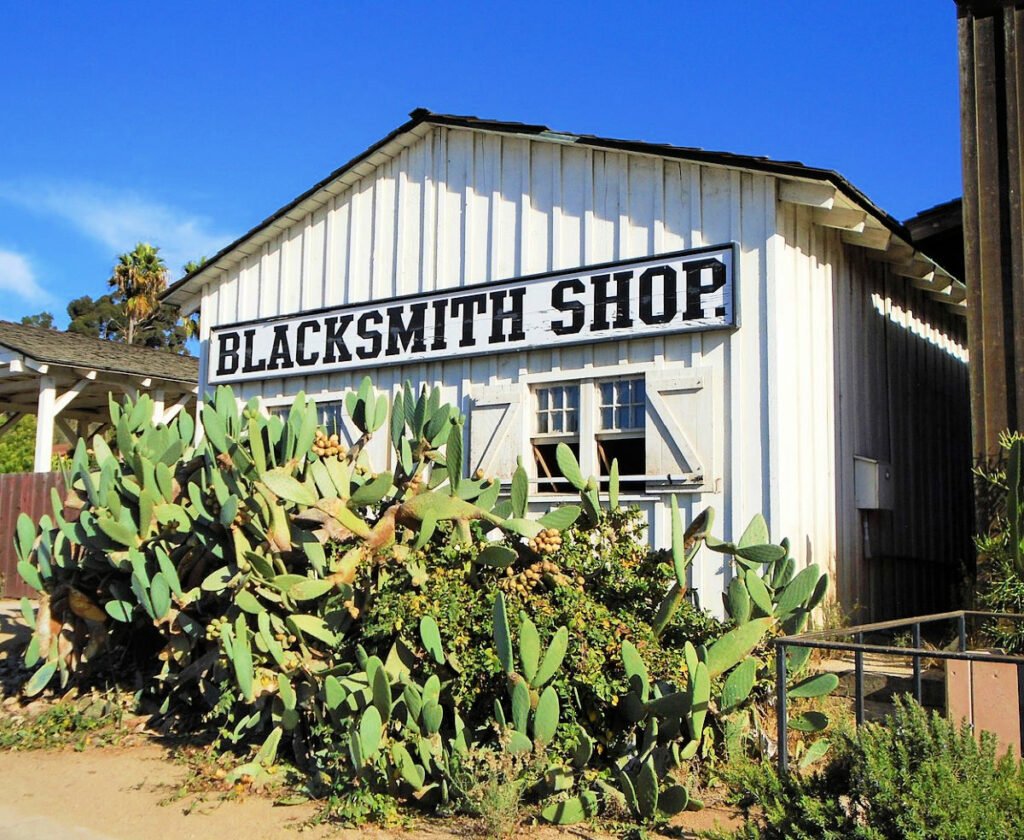
The Black Hawk Livery was originally part of the Bandini property (see Casa de Bandini). It was probably where the Bandini family’s servants lived. John Hinton, a local business man, bought the building from the Bandini Family in 1868. He used it for his livery business 1850 and 1871. A livery is a business that boards and cares for people’s horses. The Black Hawk Livery also rented out carriages, which were as expensive as a house.
Albert Seeley bought the livery in 1872 and used it as a part of his stagecoach business. He ran several stagecoach lines, including the first daily stagecoach route between San Diego and Los Angeles, until 1887 when he sold the business.
The livery is currently a blacksmith and woodworking shop where park visitors can watch demonstrations and learn about how things were made in the Nineteenth Century.
Casa de Aguirre
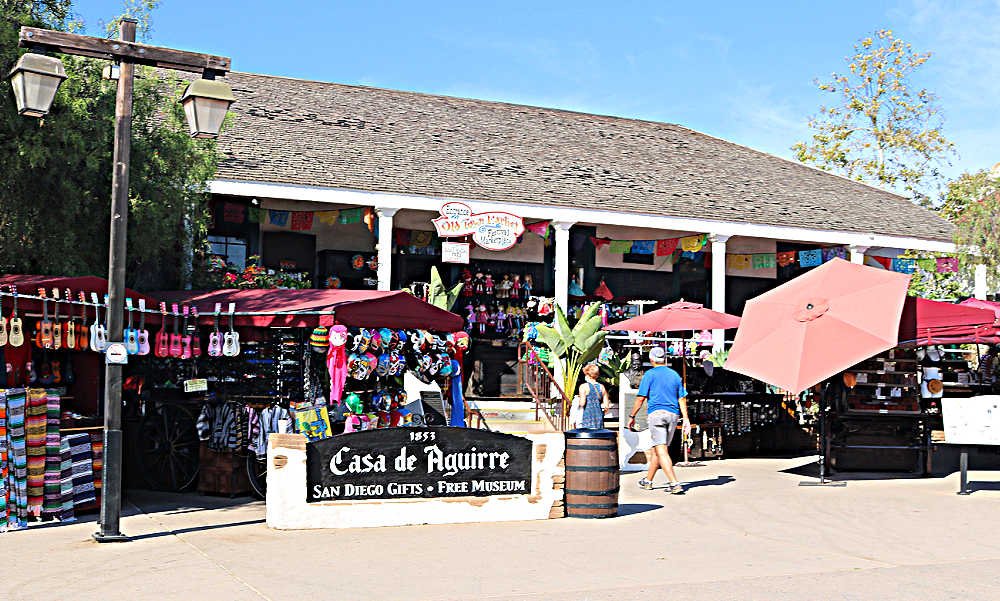
- AdobeMansion
- Built in 1853
- Reconstructed in 2002
- Now a shop and a museum
Casa de Aguirre was an adobe mansion built by Don Jose Antonio Aguirre, and was one of the first houses in San Diego. He built Casa de Aguirre so that his wife, Maria del Rosario Estudillo, could live near her family. They lived in San Diego in La Casa de Estudillo.
Don Antonio was a wealthy merchant and ranchero. He imported luxury goods for the Californios, and exported hides and tallow to South America and China. He moved to San Diego because he was kicked out of Mexico after he supported Spain in their war for independence. Don Antonio was a generous man. He paid for many of the young town’s public projects, including the old adobe church that still stands in Old Town San Diego.
After Don Antonio died, his widow, Donated the house to the Catholic church. The church opened Saint Anthony’s Indian School in the house in 1886. The school was run by Father Antonio Ubach. He worked to help educate the local indigenous population and protect their land, culture, and way of life. However his critics say that his school continued the Spanish colonization process by stripping Native American children of their language and culture. The school closed in 189,1 and it was moved to Mission San Diego.
Once the school moved, Casa de Aguirre sat empty and fell into disrepair. It was torn down in 1914. In 1994, an archaeological excavation began at the site. It uncovered the original foundation of the house and many artifacts from both the Aguirre family and the Indian school. The building was reconstructed in 2002, and is now part of the Old Town Marketplace. Casa de Aguirre has a small museum inside that displays many of the artifacts that were found during the archaeological dig, and a large gift shop.
Casa de Bandini/Cosmopolitan Hotel
- Adobe House
- Built in 1827
- Renovated in 1869, 1928, 1950s, 2009
- Now an operational hotel and restaurant
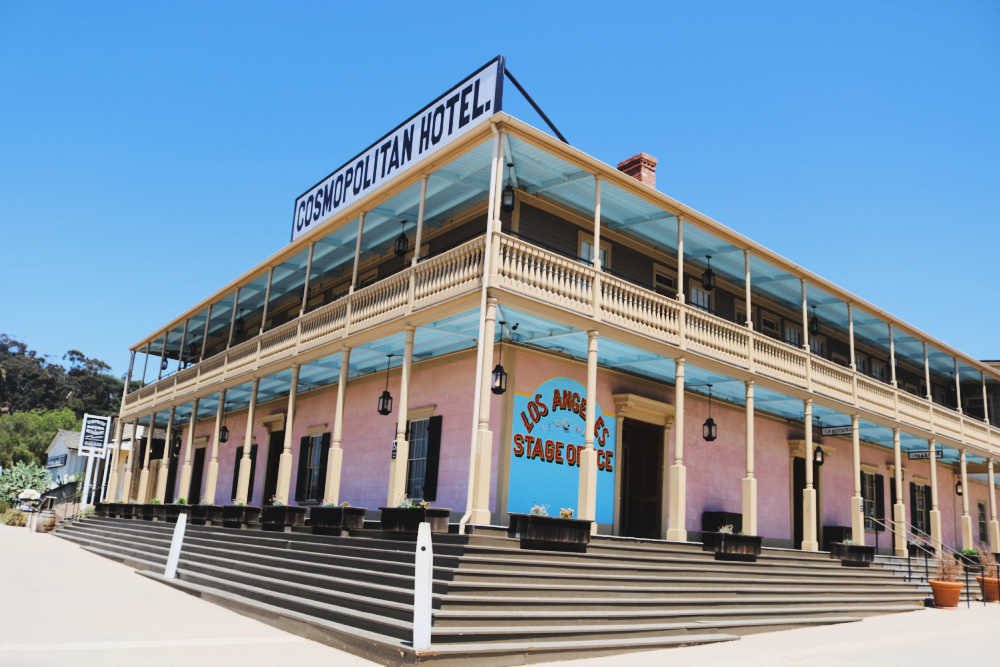
Casa de Bandini was built in 1827 by Juan Bandini. He was a Californio soldier who became a ranchero and politician after Mexico gained its independence from Spain. The house was originally a one-story adobe building. It had 12 rooms and a thatched roof. The Bandini home was the center of San Diego society at the time, and Juan Bandini often the hosted of days-long fandangoes there. A fandango was a dance party. Bandini was forced to sell the house in 1859 to pay off his debts.
Albert Seeley bought Casa de Bandini in 1869. He turned the house into a hotel, and renovated the adobe house and had the wood-frame second story built. He named it the Cosmopolitan Hotel. Seeley sold the hotel in 1888 because San Diego’s business center had moved to the Gaslamp Quarter and the railroad had made the stagecoach business obsolete.
The Cosmopolitan Hotel changed hands several times over the next 75 years, until it was finally sold to the State of California in 1968. Its most recent renovation was in 2009, and it is now a hotel and restaurant.
Colorado House/Wells Fargo Museum
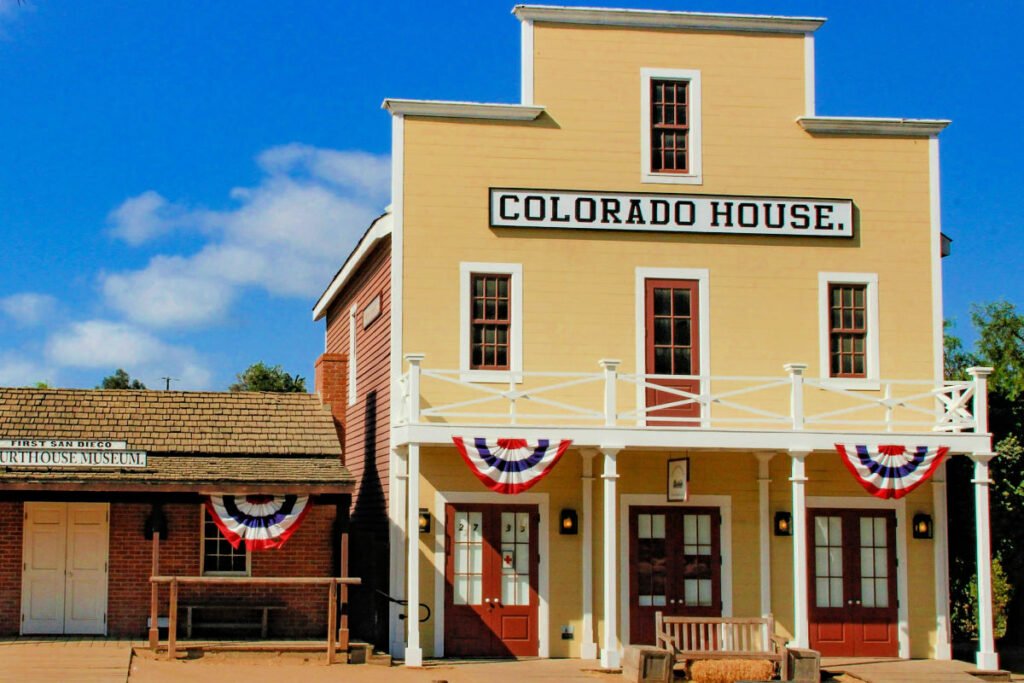
- Wood frame hotel
- Built in 1850
- Reconstructed in 1992
- Now holds the Wells Fargo San Diego History Museum
Colorado House was built in 1850 by Cave Johnson Coots, who was an American soldier from Tennessee. From 1848-1851, he was stationed in San Diego, San Luis Rey, and Los Angeles. He built the Colorado House while he was serving in San Diego. The two story hotel had an old west false front and a veranda.
Before he could move in, Coots fell in love and married Ysadora Bandini. They were gifted over 2200 acres of land as a wedding gift, and moved to their new rancho after their honeymoon. He would eventually become one of the wealthiest rancheros, and men, in Southern California.
Unfortunately, working on the rancho left Coots no time to devote to his hotel in Old Town. Instead of operating it himself, he leased it out to a string of businesses, including a surgeon, a The San Diego Herald newspaper, a hairdresser, and a jeweler.
He sold the Colorado Hotel in 1866, and it burned down in 1872. The building was reconstructed in 1992, and is now home to the Wells Fargo San Diego History Museum.
Johnson House
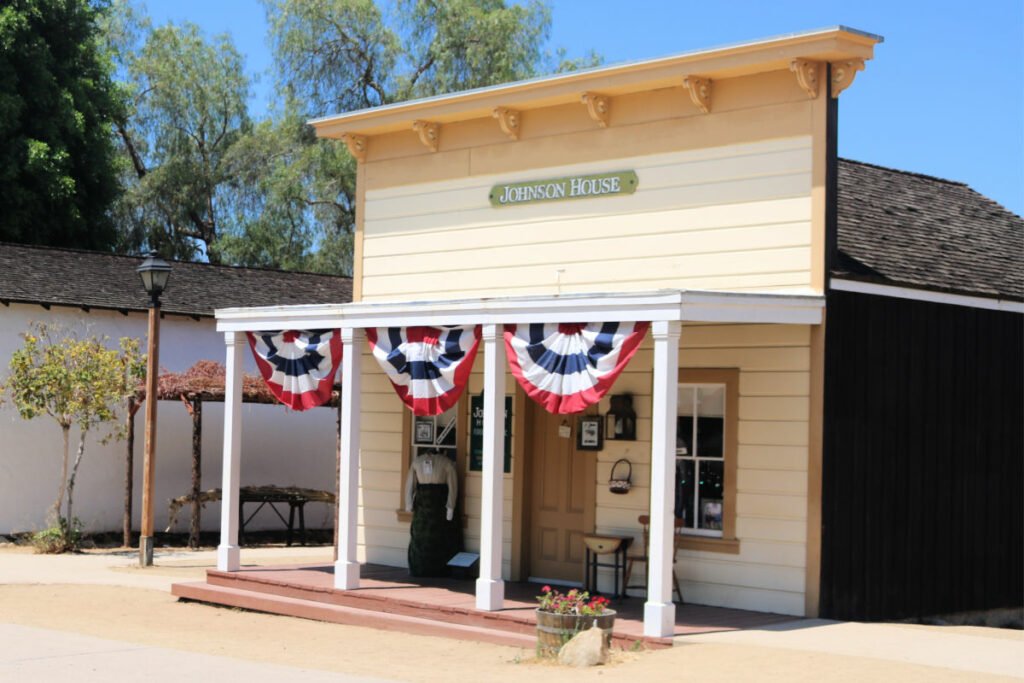
- Prefabricated House
- Built in 1870
- Reconstructed in 1989
- Now a concession shop
George Johnson bought this lot from his mother-in-law, Tomasa Pico de Alvarado in 1869, and had this office built on the property the next year. The Johnson House is a prefabricated office building that was assembled back east and sent to San Diego on a ship that traveled around Cape Horn at the tip of South America.
In 1880, the Johnsons lost their rancho to creditors and moved into their office in Old Town. The building was rebuilt in 1989, and is now the home of a period costume and millinery shop.
La Casa de Estudillo
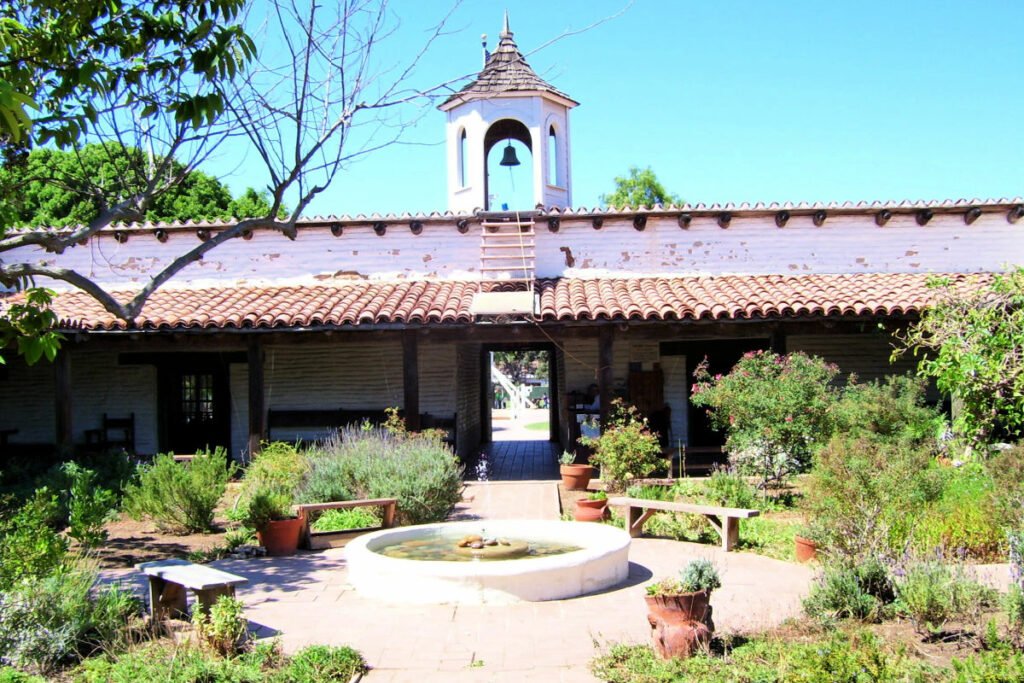
- Adobe house
- Built before 1830
- Renovated in 1906 and 1972
- Now a museum portraying life in the mid Nineteenth Century
The Estudillo Family
Sitting on the south end of La Plaza de Armas sits a beautiful white adobe mansion. La Casa de Estudillo was one of the first houses built in what would become Old Town San Diego, and was the home of the influential Estudillo family.
Jose Antonio Estudillo, built the house between 1827 and 1829. It consisted of twelve rooms in a u-shaped building surrounding a courtyard. On the southern roof there is a turreted balcony from which the Estudillo family watched horse races, bull fights, and other events that happened on the plaza. Jose Antonia Estudillo, and his wife, Maria Victoria Dominguez de Estudillo lived in the house for many years, and raised 21 children there, nine of whom were adopted.
La Casa de Estudillo, along with La Casa de Bandini, was the place to be in the earliest days of San Diego, with many parties and religious events held there. After the last members of the Estudillo family moved out of the home until 1887, it sat vacant and fell into disrepair.
Ramona’s Marriage Place
In 1884, Helen Hunt Jackson wrote a book called Ramona. It was about a woman who was half European and half Native American. She fell in love with and secretly married her Native American man, even though it was forbidden. The book follows their adventures through Southern California, and showed how terribly California’s Native Americans were treated.
The book became so popular that people traveled to California to see the places that were vividly described in the story. Some of the locations, such as Mission San Gabriel, were real places. Other places in the book, however, including the place where Ramona and her second husband were married, were fictional.
Tourists came to Old Town San Diego and wanted to see where Ramona and Alessandro had been married soon after the Estudillo family moved out of La Casa de Estudillo. The caretaker of the empty house would take them on tours of the mansion and sell them “souvenirs” he found, including bits of crumbling plaster from the home’s walls.
In 1906, John Spreckles and his San Diego Electric Railway Company bought La Casa de Estudillo, had it renovated, and opened it as a tourist attraction. He called it “Ramona’s Marriage Place” to cash in on the popularity of the book. Every few years the story was retold through movies and radio and television shows. Each time it was remade, a new wave of tourists came to see the place where Ramona married her true love.
California State Park
In 1968, La Casa de Estudillo was donated to the state of California, and became part of the California State Park system. It is the only individual building in Old Town San Diego State Historic Park to be listed on the National Register of Historical Places. It is currently a museum which gives visitors a sense of what it was like to live in San Diego in the late Nineteenth Century.
La Casa de Machado y Silvas
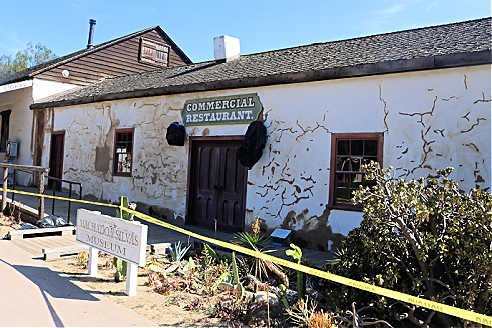
- Adobe house
- Built circa 1843
- Restored in 1968
- Now a concession shop
La Casa de Machado y Silvas was built by Jose Manuel Machado. He then gave it to his daughter, Maria Antonia, as a wedding gift when she married Jose Antonio Nicasio Silvas. It is one of the original adobe houses that sits along the Plaza de las Armas. In 1852, Maria Antonia turned the house into a restaurant, which she operated as Antonia Restaurant. The family owned the house until the 1930s. During the Mexican American War, the Silvas family took the Mexican flag from the Plaza de las Armas and hid it in their house so the Americans would not be able to find it.
In 1968, it was restored and became part of the California State Parks. Today it is a museum that shows what the adobe looked like when it was Antonia Restaurant.
La Casa de Machado y Stewart
- Adobe house
- Built circa 1835
- Restored in 1968
- Now a museum showing life during California’s Mexican Era

La Casa de Machado y Stewart was built by Jose Manuel Machado, one of the soldiers stationed at the Presidio. He and his wife, Maria Serafina Valdez de Machado, raised 15 children in the two-room adobe house.
Their youngest daughter, Rosa Machado, inherited the house in 1861, and lived there with her husband, John Stewart. They improved the house by adding new rooms to it, as well as giving it a clay roof, wood-paned windows, and a piazza where they could host outdoor gatherings.
The Machado y Stewart family lived in the house until 1966. This is when they sold it to the State of California and it became part of the California State Parks system. It was restored in 1968 and became a museum that shows visitors what a home would have looked like during the Mexican Era of California history.
La Casa de Machado y Wrightington
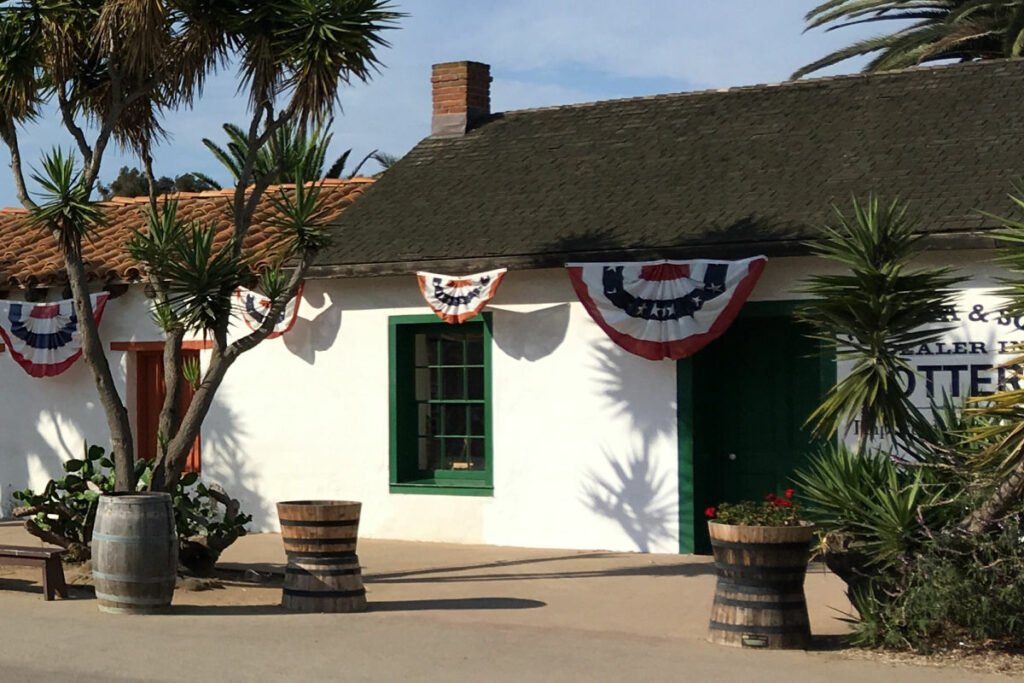
- Adobe house
- Built circa 1830
- Reconstructed in 1985
- Now Tafoya and Son, a shop that sells handmade goods by local and Mexican artisans
This is the adobe house that Jose Manuel Machado built for his daughter Juana and her first husband, Damasio Alipas. After he died, she married Thomas Wrightington, and they lived in the house. Juana lived in the house until the 1890s, and became the town midwife and healer. She grew many of the plants used in her remedies in her garden behind her house.
La Casa de Machado y Wrightington fell into ruins in the early 20th Century. The California State Parks system rebuilt it in 1985. Today it is home to Tafoya and Son, a shop that sells Mexican pottery and gifts made by local, Mexican, and South American artisans.
La Casa de Pedrorena de Altamirano
- Adobe house
- Built in 1869
- Restored
- Now a MIner’s Gems and Minerals Store
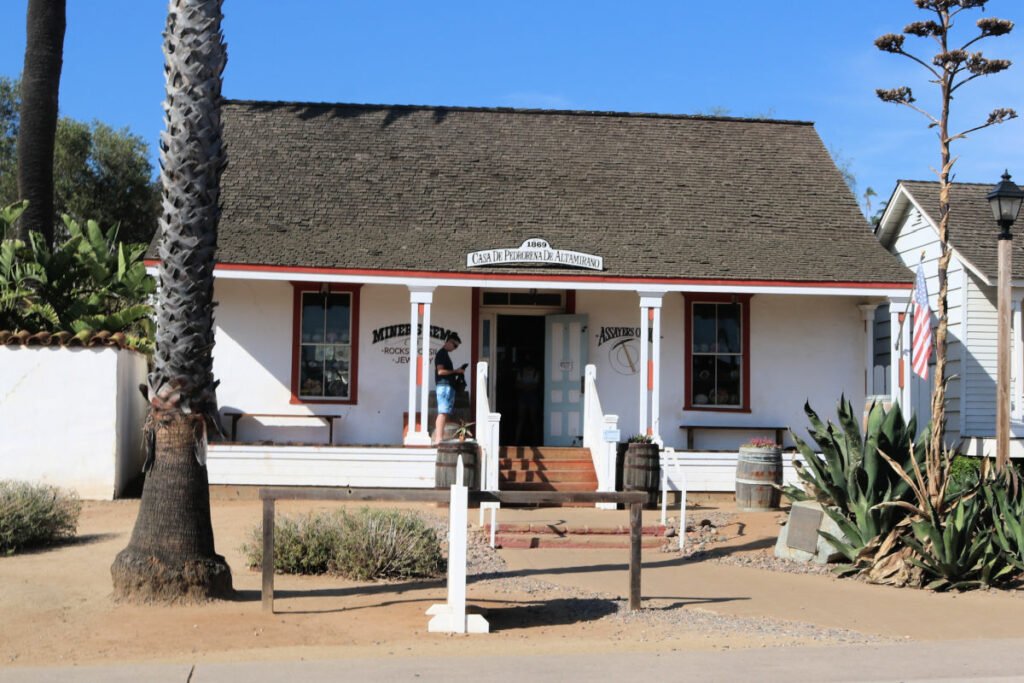
La Casa de Pedrorena de Altamirano was built by Miguel Pedrorena, Jr in 1869. He was one of Don Jose Antonio de Estudillo. This home was the last of the adobe houses that was built in Old Town. It is said that Miguel de Pedrorena saved the Spanish gun “El Jupiter” when he hid it by burying it in his yard.
In 1871, Miguel Jr’s sister, Ysabel Pedrorena de Altamirano, and her husband, Jose Antonio Altimirano, moved into the house, and raised their family there. The house was occupied by the Altimirano family until 1907. After that it was used for a variety of businesses.
The house is now the home of Miner’s Gems and Minerals store. They have an assortment of gems, minerals, jewelry, etc. Their staff is knowledgeable about gems and minerals, and can tell you all about the mining artifacts found in and around the shop. When you go to Old Town San Diego State Historic Park, be sure to stop by an pan for gold behind the building. It is a fun experience for the whole family.
La Casa de Rodriguez/Racine & Laramie
La Casa de Rodriguez, one of the original adobe houses in Old Town, was built by Juan Rodriguez, a retired soldier from the Presidio. In 1851, George Tebbetts, Rodriguez’s son-in-law, opened the Exchange Hotel in the house. The building was rented to Alexi Racine and Charles Laramie in 1869. They opened a general store that specialized in tobacco, pipes, and cigars. It was the first tobacco shop to operate in San Diego.
The building was destroyed by a fire in 1872. It was rebuilt in 1974, and serves as a modern version of Racine and Laramie’s tobacco shop. It is furnished with antiques, and has an antique pipe museum inside.
Mason Street School
- Wood Frame One Room Schoolhouse
- Built in 1865
- Reconstructed in 1952
- Now a concession shop

Mason Street School was San Diego’s first public school. The wood-frame building was a one-room schoolhouse where eight grades were all taught in the same room. 42 children were enrolled in the school in 1866. Another, bigger school was built in 1872. Once that school opened, Mason Street School was closed. The building was taken apart and rebuilt somewhere else. It became someone’s home, and later opened as a tamale restaurant.
The building was bought by San Diego County Historical Days Association in 1952. They moved it back to its original location and restored it so that it looked like a Nineteenth Century schoolhouse. In 2013, California State Parks assumed ownership of the schoolhouse and it became a California State Landmark. Visitors to Old Town San Diego State Historic Park can tour the school and see what it was like to go to school in the 1860s.
McCoy House

- Wood Frame House
- Built in 1869
- Reconstructed in 2000
- Now a history museum
The McCoy House is a wood-frame house that was built in 1869 by the local sheriff as a wedding gift for his wife, Winnifred Kearny McCoy. Unfortunately, it was built on the site of the indigenous Kumeyaay village of Kosa’aay.
Sheriff James McCoy was an Irish immigrant who served as California’s first sheriff. He also served as the County Assessor and as a state senator. He died in 1895.
In1916, the house was transferred to Winnifred’s second husband, Francis Murtha, later becoming the site of a Christian Workers’ Home. Today, the house is a history museum that takes visitors on a journey through San Diego’s rich and interesting history.
Robinson-Rose House
- Wood Frame and Adobe House
- Built in 1853
- Restored
- Now a concession shop

The Robinson Rose House was built in 1853 as the law office and home of James W. Robinson. Robinson was very influential not only as a successful lawyer, but as an investor and promoter of San Diego, and as a school board trustee. He died in 1857, after which his widow sold the house to Louis Rose for $10,000.
The roof of the Robinson Rose House was destroyed by a fire in 1874. After that, the house fell into disrepair, and was demolished in 1900. California State Parks reconstructed it in 1989. It is currently the visitor information center for Old Town San Diego State Historic Park. This is where visitors can talk to park rangers to learn more about Old Town and sign up for a walking tour of the park. The visitor information center has a really neat diorama of Old Town and how it probably looked in 1872.
San Diego Courthouse
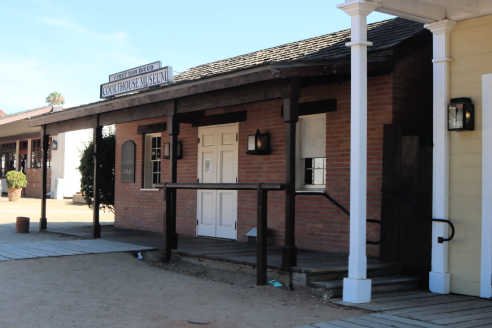
- Brick Building
- Built in 1847
- Reconstructed in 1992
- Now a museum showing what city offices looked like in the 1800s
This brick building was San Diego’s first court house, and its first building made from fired bricks. It was built by members of the Mormon Battalion, who were stationed in town and helped the community with public service projects. Originally meant to be a town hall, was the alcalde’s office between 1847 and 1850. It held the city mayor and city clerk’s offices and served as the city and county courthouse from 1850 to 1869. The courthouse builiding was also used as a church, a school, a meeting place, and San Diego’s election polling place.
In 1872, many of Old Town’s buildings were damaged or destroyed in a fire that started in the courthouse. The courthouse was one of the buildings that was destroyed. It was rebuilt in 1992, and now has a courthouse museum inside that shows what city government was like in the mid-1800s.
San Diego House
- Adobe house
- Built in 1847
- Reconstructed in 1985
- Now a concession shop
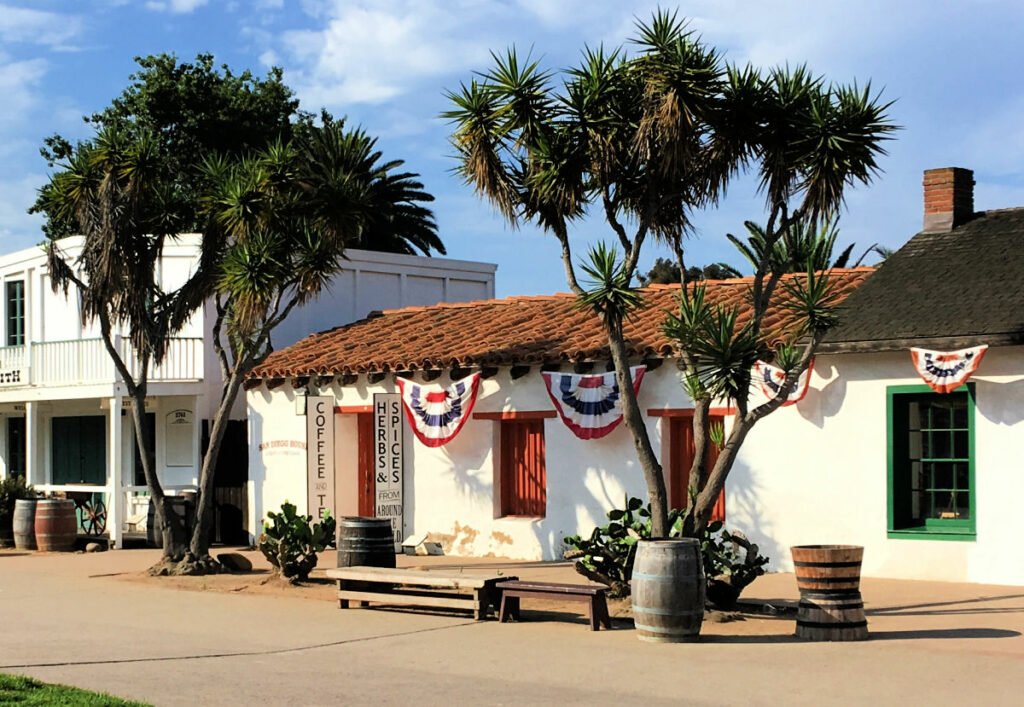
In 1847, Richard Freeman and Allen Light bought this newly built house from the Machado family. Freeman and Light were African American men who were prominent San Diego citizens. Richard Freeman was San Diego’s first African American Police Officer. The two men named their home San Diego House and operated a saloon there for many years.
The house was passed to Freeman’s daughter, Anita, in 1851. It was destroyed in a fire in 1858, and was reconstructed in 1985. Today it is a coffee and tea shop in the heart of Old Town.
San Diego Union Building
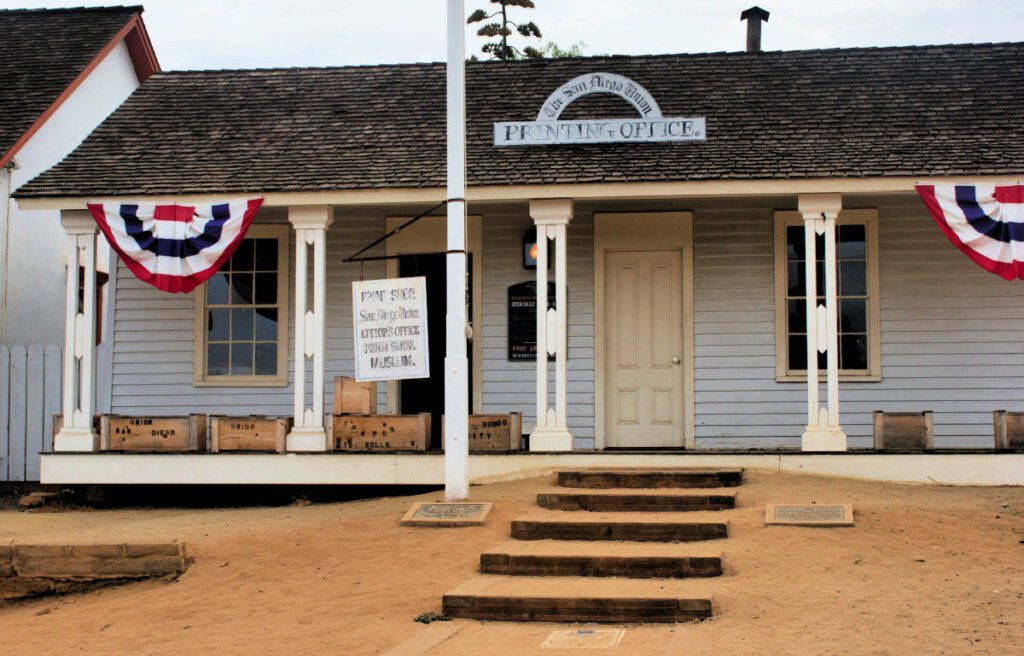
- Adobe house
- Built Circa 1851
- Restored in 1967
- Now a newspaper museum
The San Diego Union Building originally belonged to the Pedrorena family, and was most likely used as a store. The prefabricated wood-frame building was assembled on the East Coast and shipped around Cape Horn to San Diego. This building was rented to the San Diego Union newspaper in 1868, and is the place where the newspaper got its start. The first edition of the paper was printed here on October 10, 1868. It moved to New Town (The Gaslamp Quarter) in 1870, and is still in publication today as the San Diego Union-Tribune. It was restored in 1967, and now is a newspaper museum with a recreation of what a newspaper office looked like in 1868, including an 1860s printing press.
Seeley Stable
- Wood Frame Stable
- Built in 1869
- Reconstructed in 1974
- Now a transportation museum
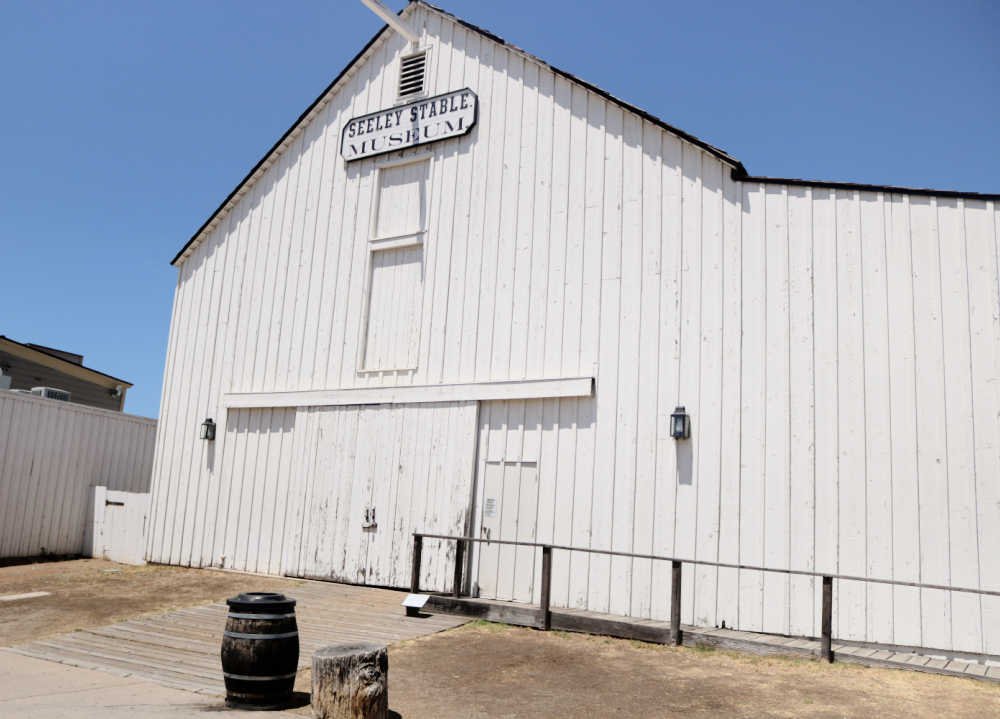
Albert Seeley built the Seeley Stable in 1869 after he bought Casa de Bandini. It was where he kept the coaches, wagons, and horses he used in his stagecoach business. It is located next to the Cosmopolitan Hotel, where the stagecoach stop was located.
The stable was demolished in 1920. It was rebuilt in 1974, and is now home to a transportation museum that houses an amazing collections of stagecoaches, wagons, and related artifacts.
US House
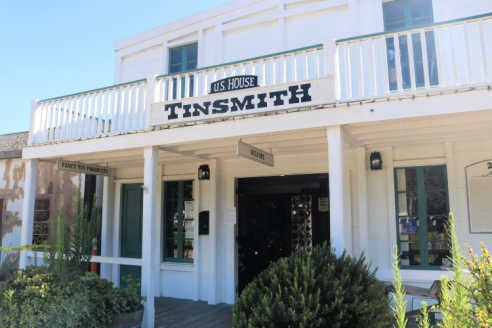
- Prefabricated Wood Frame House
- Built in 1850
- Reconstructed
- Now a Tinsmith Shop
The U.S. House is an interesting building because of how it was constructed. It is a prefabricated building that was bought in San Francisco in 1850 and assembled in San Diego. Unfortunately, it was accidentally assembled inside out. Over the years it was a general store, a boarding house, a bar, and a restaurant. It was eventually restored, and now operates as a tinsmith shop.
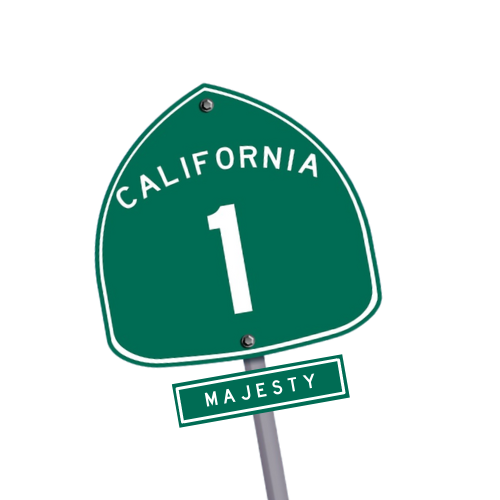


Recent Comments